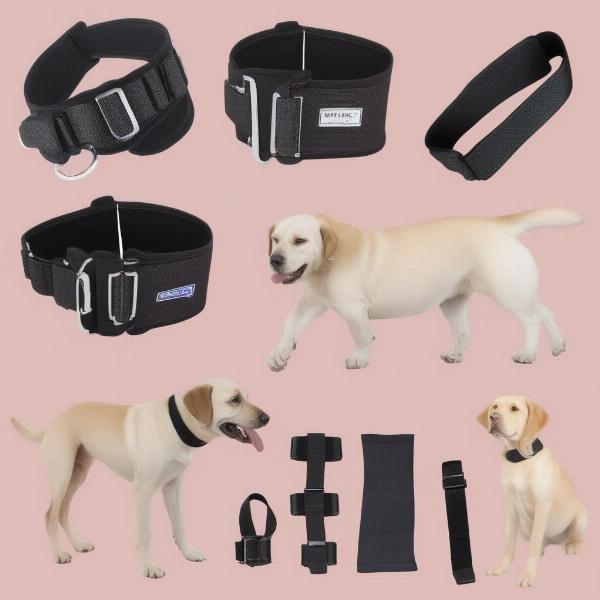A dog shoulder brace can be a valuable tool for supporting your canine companion’s shoulder joint, aiding in recovery from injuries, and managing chronic conditions. Whether your dog is recovering from surgery, experiencing arthritis, or simply needs a little extra support, choosing the right brace can significantly improve their comfort and mobility. This guide provides a comprehensive look at dog shoulder braces, covering everything from the benefits and types to choosing the right one and ensuring proper fit.
Understanding the Need for a Dog Shoulder Brace
Why might a dog need a shoulder brace? Several conditions can benefit from the support a brace offers. These include:
- Arthritis: A shoulder brace can help stabilize the joint, reduce pain, and improve mobility in dogs suffering from arthritis.
- Post-Surgery Recovery: After shoulder surgery, a brace can provide support and limit range of motion, promoting healing and preventing re-injury.
- Soft Tissue Injuries: Sprains, strains, and other soft tissue injuries can be supported and stabilized with a brace, helping to reduce pain and swelling.
- Shoulder Instability: For dogs with loose or unstable shoulder joints, a brace can provide added stability and prevent further damage.
Types of Dog Shoulder Braces
 Different types of dog shoulder braces available
Different types of dog shoulder braces available
Several types of dog shoulder braces are available, each designed for specific needs and conditions. Common types include:
- Sleeve-Type Braces: These offer basic compression and support, suitable for mild injuries or general support.
- Strapped Braces: These braces incorporate straps and adjustable closures, allowing for a more customized fit and greater support.
- Hinged Braces: Designed for post-surgical recovery, hinged braces offer more control over range of motion, preventing excessive movement.
- Custom-Made Braces: For dogs with unusual conformations or specific needs, a custom-made brace may be the best option to ensure a perfect fit and optimal support.
Choosing the Right Dog Shoulder Brace
Selecting the appropriate brace for your dog is crucial for ensuring its effectiveness and your dog’s comfort. Consider the following factors:
- Severity of the Condition: Mild injuries may benefit from a basic sleeve, while more serious conditions require a more supportive brace.
- Your Dog’s Size and Breed: Braces are available in various sizes to accommodate different breeds. shoulder brace dog
- Veterinary Recommendations: Always consult your veterinarian for guidance on choosing the most suitable brace for your dog’s specific needs. pressure sore on dog
- Material and Comfort: Look for breathable materials that won’t irritate your dog’s skin.
Ensuring a Proper Fit
A well-fitting brace is essential for comfort and effectiveness. Follow these guidelines:
- Measure Your Dog Accurately: Refer to the manufacturer’s instructions for specific measurement guidelines.
- Adjust the Brace Properly: Ensure the brace is snug but not too tight, allowing for proper circulation.
- Monitor Your Dog for Discomfort: Watch for signs of rubbing, chafing, or restricted movement. cervical intervertebral disc disease in dogs
- Consult Your Veterinarian: If you have any concerns about the fit or your dog’s comfort, consult your veterinarian. bunty dog harness
Living with a Dog Shoulder Brace
Introducing a brace into your dog’s life requires patience and understanding. Gradually acclimate your dog to wearing the brace for short periods, rewarding them with positive reinforcement. Ensure they have comfortable bedding and ball therapy for dogs can also help with overall comfort. Regular veterinary check-ups are vital to monitor the progress and adjust the treatment plan as needed.
Conclusion
A dog shoulder brace can be an invaluable tool in managing various shoulder conditions and injuries. By understanding the different types of braces available, choosing the right one for your dog’s specific needs, and ensuring a proper fit, you can significantly improve their comfort, mobility, and quality of life. Remember to consult your veterinarian for professional guidance and to monitor your dog’s progress regularly.
FAQ
- How long should my dog wear a shoulder brace? This depends on your dog’s individual condition and your veterinarian’s recommendations. It can range from a few weeks to several months.
- Can my dog sleep with a shoulder brace? In some cases, yes. Your veterinarian will advise on the best course of action for your dog’s situation.
- Are there any side effects to using a dog shoulder brace? Potential side effects include skin irritation or pressure sores if the brace doesn’t fit correctly. Regular monitoring is important.
- How do I clean my dog’s shoulder brace? Follow the manufacturer’s instructions for cleaning. Most braces can be hand-washed with mild soap and air-dried.
- Can a shoulder brace completely cure my dog’s shoulder condition? While a brace can provide support and manage symptoms, it’s not always a cure. It is often used in conjunction with other treatments.
- Can I make my own dog shoulder brace? It’s not recommended to make a homemade brace as it may not provide adequate support or could even cause further harm if not properly designed.
- What should I do if my dog doesn’t tolerate the brace? Consult your veterinarian. They may suggest alternative treatments or ways to help your dog adjust to the brace.
ILM Dog is a leading international online resource dedicated to providing expert advice on dog care and wellbeing. From breed selection and health care to training and nutrition, we cover all aspects of responsible dog ownership. We offer a wide range of information, resources, and product recommendations to help you provide the best possible care for your furry friend. For personalized guidance or further assistance, reach out to our team of experts at [email protected] or call us at +44 20-3965-8624. ILM Dog is committed to supporting you and your canine companion on your journey together.